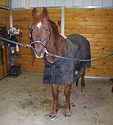Advertise Follow Us
Articles by Nicholas B Denson
Thinking Outside the Box in Farriery
One professional’s approach for finding solutions to hoof-care problems
Read More
Make Shoeing for a Vet Clinic Worth Your While
Prepare for the ups and downs to make your venture successful
Read More
Infrared Thermography: Fun Toy or Practical Tool?
Two case studies show how smartphone infrared cameras could be used by farriers
Read More
Navicular or Not?
Farrier argues that many “navicular” lameness are actually caused by something else — that requires a different trimming and shoeing approach
Read More
Neglect and Hoof-Capsule Distortion
Proper trimming and shoeing provide quick results in this case study
Read More
Clashing Views on Laminitis
A noted farrier questions the basis of an article in the May/June issue and the author responds
Read More
Viewing Laminitis with Fresh Eyes
Massachusetts farrier offers a new perspective: Just for starters, he says P3 doesn’t rotate
Read More

.jpg?height=125&t=1740082949&width=150)










